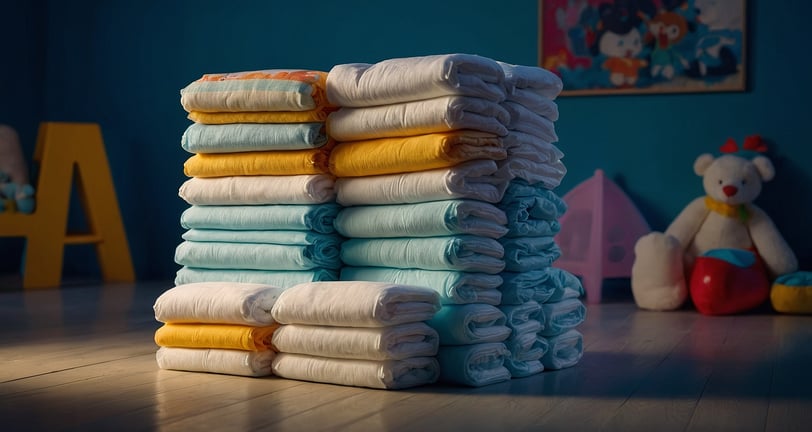Diapering and Bathing Basics for New Parents: A Comprehensive Guide
Discover essential diapering and bathing tips for new parents in our comprehensive guide, designed to ensure your newborn's comfort and hygiene with confidence and ease.


Welcoming a newborn into your family brings immense joy and a host of new responsibilities. Among the many tasks new parents must master, diapering and bathing are essential for ensuring your baby's comfort, hygiene, and overall well-being. In this comprehensive guide, we'll walk you through everything you need to know about diapering and bathing your newborn with confidence and ease.
1. Choosing the Right Diapers
One of the first decisions new parents face is choosing between cloth and disposable diapers. Each option has its advantages, so consider what works best for your family's lifestyle, budget, and environmental concerns.
Cloth Diapers: Environmentally friendly and cost-effective in the long run. They require more laundering but come in various styles, including prefolds, fitted, and all-in-one.
Disposable Diapers: Convenient and easy to use, especially for busy parents. They offer excellent absorbency and come in sizes that grow with your baby.
Whichever type you choose, ensure a snug but comfortable fit to prevent leaks and discomfort for your baby. Consider trying a few brands initially to see which works best for your baby's skin and your preferences.
2. Diaper-Changing Essentials
Before each diaper change, gather your essentials to streamline the process and keep your baby comfortable:
Diapers: Have several clean diapers within easy reach.
Wipes: Choose alcohol-free, hypoallergenic wipes suitable for newborns.
Diaper Rash Cream: Protect your baby's skin from irritation with a gentle, zinc oxide-based cream.
Changing Pad or Towel: Provide a clean, soft surface for diaper changes, whether at home or on the go.
Keep these supplies organized and accessible in a designated changing area to make diaper changes quick and efficient.
3. Proper Diaper-Changing Technique
Changing diapers is a skill that improves with practice. Follow these steps for a safe and hygienic diaper change:
Prepare: Lay your baby on their back on a changing pad or towel.
Remove: Open the dirty diaper, gently lifting your baby's legs. Use the front half to wipe away any mess while keeping your baby covered.
Cleanse: Use wipes to thoroughly clean your baby's diaper area, wiping from front to back to prevent infections.
Dry: Allow the area to air dry briefly or pat gently with a clean cloth before applying diaper rash cream.
Secure: Position the clean diaper under your baby, fastening it snugly but not too tight to allow for comfort and movement.
Regular diaper changes, approximately every two to three hours or as needed, help prevent diaper rash and keep your baby feeling fresh and dry.
4. Understanding Baby's Cues
Newborns communicate their needs through cues such as fussiness, squirming, or crying. Pay attention to these signals, especially during feedings and before bedtime, as they often indicate the need for a diaper change. Establishing a routine around diaper changes can help keep your baby content and minimize discomfort.
5. Safe and Effective Bathing Practices
Bathing your newborn is not only about keeping them clean but also a chance for bonding and relaxation. Follow these steps for a safe and enjoyable bath time experience:
Prepare: Gather all necessary bath supplies: mild baby soap, soft washcloths, towels, and a clean diaper.
Temperature: Fill a baby tub or sink with warm water (not hot) and test the temperature with your wrist or elbow to ensure it's comfortable for your baby.
Support: Hold your baby securely with one hand, supporting their head and neck, while using the other hand to wash gently with soap and water.
Cleanse: Start with the face, using a damp cloth to wipe eyes and around the nose. Then, move to the body, focusing on creases and folds where dirt and moisture accumulate.
Rinse: Rinse your baby thoroughly with clean water to remove soap residue, ensuring they stay warm throughout the process.
Dry and Dress: Lift your baby out of the bath and wrap them in a soft towel, patting gently to dry. Apply baby lotion if desired, then dress your baby in clean clothes and a fresh diaper.
6. Safety Precautions
Bath time requires careful supervision to prevent accidents and ensure your baby's safety:
Never Leave Unattended: Always keep one hand on your baby during bath time to prevent slipping or accidents.
Secure Environment: Keep all bath products within reach but out of your baby's grasp. Ensure the room is warm and free of drafts to keep your baby comfortable.
7. Post-Bath Care
After bath time, continue to care for your baby's skin and nails:
Nails: Trim baby's nails with baby-safe nail clippers or file gently to prevent scratching.
Skin: Moisturize your baby's skin with a gentle baby lotion to keep it soft and hydrated, especially in dry climates or seasons.
Ears and Face: Clean behind your baby's ears and around the face with a soft cloth to remove any residual dirt.
8. Enjoying Bath Time Together
Make bath time a special bonding experience by engaging with your baby:
Sing and Talk: Sing soft songs or talk to your baby in soothing tones to create a calming atmosphere.
Eye Contact: Maintain eye contact and smile during bath time to strengthen your bond with your baby.
9. Coping with Challenges
Diapering and bathing may present challenges, especially in the early weeks. Seek support from your partner, family, or pediatrician if you encounter issues such as diaper rash, skin sensitivity, or difficulty with bathing techniques.
10. Embracing Parenthood
Above all, embrace the journey of parenthood with patience and love. Diapering and bathing are essential tasks that provide opportunities for nurturing and bonding with your newborn. Enjoy these moments as you learn and grow together as a family.
Mastering diapering and bathing basics is a rewarding part of caring for your newborn. With practice, preparation, and a focus on safety and comfort, you'll build confidence in providing the best care for your baby's hygiene needs.
